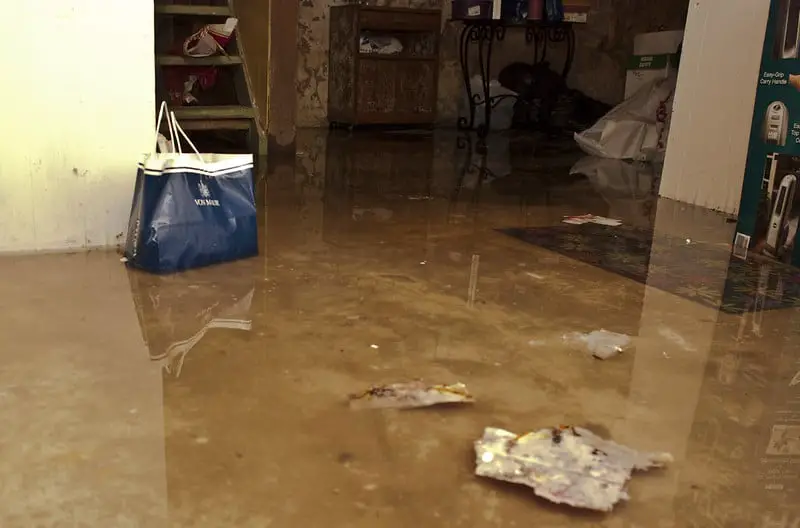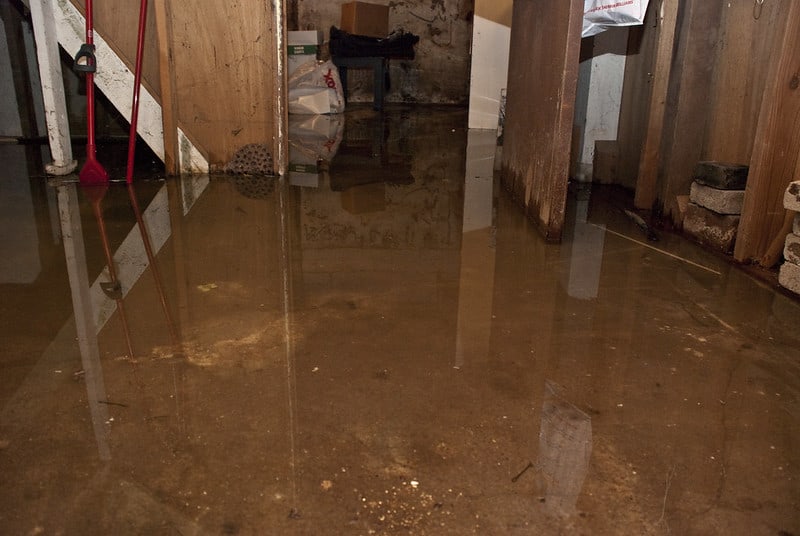Basement Flooding – Causes, Cleanup, Restoration and Prevention
The basement may flood for any number of reasons. Flood can occur where unusually large volumes of water settle and may be hard to move. If the water remains for long periods, it can cause untold damage to your home and assets.
Stagnant water in your basement can harbor mildew and mold, and some bacteria might seep into the air. Also, the items you store in it can become water-logged and become unusable. If you experience flooding, here are some steps you can take to resolve the situation.
Causes of basement flooding

You’ll first need to understand some of the reasons behind basement flood.
- Weather conditions
Heavy rainfall, snow, and storms can send lots of water in your basement. These types of events can damage the assets like foundation, furniture, and other valuable items.
- Melting snow
Frozen pipes and melting snow in winter might be another reason of flooded basements. If the pipes break under pressure, it can make your home flood. Alternatively, if the snow melts quickly, it can settle in the driveway or nearby streets, and eventually seep into your basement.
- Sewage Blocks
Most sewage systems usually sit at the lower ground and basement levels, and in some instances, above. However, the sewage and groundwater levels lie over the floor and cause water to rush into the basement. Additionally, if there are any cracks in your foundation, water will seep through in these situations. Water in the drains, washrooms, and laundry can also cause an overflow in the sewage well. If it seeps into the basement, the odors will be unpleasant and also allow germs to circulate in the atmosphere. Backups in the sewage system can send water into the basement through low-lying fixtures like toilets; floor drains, washbasins, shower drains, and sinks.
- Sewage leaks
Leaks in the main sewage lines can also cause excess water if there’s a torrential downpour or blocks in the system.
- Broken and leaky plumbing
Sometimes old, rusty, or even broken pipes around the home break away under pressure and cause water to rush into the basement. The hot and cold water lines tanks and primary sump pumps are areas that can flooded mostly. If your sump pump fails or is not well-maintained, flood can cause significant damage if you cannot control the floodwater quickly. You need to stem the flow is to shut off the valve. Another short-term measure would be to fix the leaks at the source. Long-term solutions will include upgrading and replacing the plumbing system.
- Low-lying foundations
Living in a home which is flood-prone or in a low-lying area might be another reason of basement flood. And you need to elevate the foundation slightly higher than the ground to prevent it.
- Faulty weeping tiles
Your foundation drainage system may also break down with regular wear and tear over time. If your pipe collapses or has blockages, the water level close to the foundation can overflow into the pump and get into the basement. You might have to deal with the basement flood if wastewater and groundwater can also get into there through the sewage fixtures or floor drains.
- Unsealed or poorly sealed basement areas
Any openings in the walls, tiles, and even in the basement foundation can keep the water to flood. Make periodic checks and plug any cracks to prevent water from getting in.
Some other possible cases of basement Floods
Other causes of basement floods includes faulty drains, stagnant water from heavy rain, and surface water running through the foundation. These will include:
Debris in drains and gutters
Gutters and other drainage units are necessary to redirect water from the home and keep the basement free from water and moisture. Twigs, leaves, and other stuff from flowers, trees, and shrubs on your property can clog the gutters. The debris will block the water path coming from the roof, and into the drain spout. If the gutter overflows, the excess water will creep into the basement.
Faulty drains and downspouts
Installing drainpipes and downspouts at least six feet off the home can prevent flooding in your basement. These systems help channel water off the roof, away from windows and doors and into nearby streets or your backyard. If the downspouts have leaks, cracks, or broken parts, runoff water can settle close to the home. When it occurs, the water will eventually run into it through cracks in your foundation.
Do’s & Dont’s Before the Basement Clean-Up
Do’s
Take an inventory of the items that become damaged by the floodwater. Make separate lists of what you plan to keep and what you plan to throw out. Also, take some pictures, if possible, to show the extent of the damage. It will be helpful for insurance claims
- Switch off the electrical and water supply to your home and basement.
- Call your insurance company, the city sewage department, and plumbing professionals for help.
- Call a plumbing professional to assess the damage before attempting any plumbing repairs.
- Try to locate any sources of leaks around the home and foundation and fix them if you can do so.
- Check the floor drains for any clogs that can be the source of the flood, make sure to clear them out.
- Just to be safe, wear gloves, boots, protective eyewear, and other shields to prevent coming in contact with contaminated floodwaters and water-logged items.
- Use buckets, mops, cloths, towels, and other absorbent materials to soak up some of the stagnant water.
- Take up any carpeting and move it out of the basement. Carpets and rugs hold water and moisture and may keep the floor underneath moist and slow down the drying time.
- Make sure to transfer the items that soak up water like furniture, drywall, and insulation. These can hold moisture and helps mold to grow.
- Place small plates or rubber tiles under furniture to keep the legs off wet carpets on the floor.
- Open the vents, windows, and doors and allow fresh air to reduce odors and speed up the drying process.
- Allow at least 2-3 days for wet items to completely dry out.
- Use an anti-mildew cleaner or spray on the wall and floor to slow the growth of mildew or mold in the basement.
Don’ts
- Do not walk through stagnant water unless you are wearing protective clothing.
- Avoid handling items like lamps, stereos, televisions, and other electrical items in your basement, even if the power supply is off. Make sure those are completely dry before touching them.
- Do not use bleach and other household cleaning products to clean the areas.
- Do not attempt any repairs or makeover to walls and floors.
- Avoid using a regular vacuum cleaner to draw water out.
Cleaning up the flooded basement
If your basement is flooded for any reason, you’ll need to start the cleaning process as soon as possible to minimize damage.
- Make sure it is safe to enter the flooded area. Also, look around to pinpoint any holes, cracks, or twisted wood or building material.
- Shut off the plumbing valves if the flooding occurs because of a burst main.
- Be 100% sure to disconnect the electricity from the circuit breaker. Also, check to see if there is any electrical wiring exist under the water.
- Try not to wade through floodwater. However, if you do, wear high boots, face coverings, gloves, and other ways to protect your body from possible contamination.
- If you have a primary or battery backup sump pump, use it to to drain the water away from the basement.
Steps in cleaning the basement
Push off the water immediately
Removing the flood water by using products like sump pumps, mops, buckets, or a wet/dry vacuum if you have any. You can also rent a commercial pump or use a pool pump instead. Using a squeegee to push the water into the drains may also help. You may also use a plumbing snake or plunger to clear the drains to get the water out.
Removing water-logged items
Take out all the damaged items to reduce the spread of rot, mold, and mildew. Also, transfer furniture and carpets that can absorb water.
Dry the area completely
Employ your sump pump if you have one, or use a wet-dry vacuum to absorb water and moisture.
Ventilate the area
Open the windows when necessary, or use a fan or humidifier to circulate some air in the basement. If there are baseboards, it may be helpful to drill some small holes to release any damp air from behind the walls.
Disinfect the area
After you finish drying, use some disinfectant to clean the flooded area. It will destroy any spores or mold that may be present. Remove any damp or rotting boards and other building materials from the area. Make sure to seal any cracks where moisture can build up and helps mold to grow.
How to clean sewage from the basement
If there’s a sewage leak, it is best to leave the place altogether to avoid contamination to your family and pets. Close off the basement form the other areas of the home to prevent any possible contamination.
- Switch off the power supply to avoid any electric shock.
- Protect yourself by wearing gloves, boots, and face masks if you need to enter the basement.
- Disconnect the water supply to the home.
- Avoid flushing the toilets, using the tubs, sinks, showers, and washing machines until the sewage clears away.
- Notify the city sewage company about the problem.
- Pump or drain the sewage water and any material out of the basement.
- Wash down the floors, walls, and other areas.
- Rinse the whole place and item where possible with warm water.
- Disinfect the space to slow the spread of spores, viruses, and infections from the sewage water.
- Open the windows and doors to allow some clean air inside the basement space.
How to prevent basement flood

Whether you like it or not, you have to always follow the below tips to protect your basement from the water damage:
Invest in a sump pump
A sump pump is an excellent backup to get rid of floodwater quickly. The pump can also sweep away excess water if there’s a power outage when flooding occurs.
Plug the cracks
Cracks and crevices in basement foundations and walls may cause water and moisture to get into the area. Set a regular maintenance plan to seal these areas to prevent basement floods.
Clear your gutters and downspouts
Dry leaves, small pebbles, and other objects may block down drains and gutters and can cause flooding. Clear these areas often and also channel some of the water into troughs or extension pipes.
Clean the wells and septic tanks
Clean your wells and septic tanks at regular intervals to avoid any backups in the sewage system. Repair any leaky sewage valves to prevent basement floods. Dumping and flushing excess items into the sewage system may also cause blocks and flooding. Flush the toilets properly to reduce backups that can cause flooded basements.
- Allow only toilet paper to pass through the toilet drains.
- Avoid sending excess chemical substances into the sewage system.
- Do not drain oils, grease, and fats from the kitchen into the sewage plumbing.
Fix the pipes
Fix and repair leaks and damage to your pipes and drains to stem the flow of water entering and flooding your basements.
Waterproof the basement
A damp, wet basement can start to smell moldy and musty and affect your health. Waterproofing it can save you the stress and repair and replacement costs going forward. Before you begin, make a check to ensure you get the best possible waterproofing items for your basement area. Find out which solution is right for your flooding problem. Locate the areas that are leaking like around the foundation, windows, or at the ground level.
It will ensure you protect areas like walls, window drains, and stairwell drains from leaks and cracks. It will help you decide the best ways to fix the leaks.
- Interior and exterior sealers
- Interior draining products
- Exterior waterproofing products
Repairs
Fix all cracks, and clean all drains and down pipes and gutters. Remove debris to keep water flowing freely around the foundation areas. Keep a reasonable distance between the drainpipes and your home to help channel water away and reduce flooding.
Use sealers when appropriate
Some experts advise against applying some at-home sealants to plug leaks around the home. They suggest sealants are primarily short-term fixes and not a full-proof solution of the leaks. However, they advise using a type of hydraulic cement as an alternative to prevent cracks.
Prepare yourself for the future
After completing the waterproofing the process, contact with your insurance company. Check whether your insurance plan includes the compensation for basement floods or not. If it is not included try to increase your overall household coverage may provide funds if it occurs.
FAQ
How long does it take to clean the basement?
While initial cleaning can take several hours, it can take up to two weeks to be free of any moisture or floodwater.
How do I ventilate the basement?
You can use a fan or humidifier to increase good airflow in the basement. You can also open any vents, windows, or doors to eliminate the moisture in the atmosphere and bring in dry air.
How to avoid electric shock when the basement is flooded?
When flooding occurs, it’s a good idea to disconnect the power supply from the circuit breaker. Make sure that it’s already off or not. Also, if you plan to enter the basement, check for any low hanging or underwater cables that can be life threatening. Avoid wading through the water with visible electric wires to avoid any possibility of shock.
How to deal with gas odors in the basement?
Gas pipes may burst during flooding and may originate odors to escape. If you detect gas during the period, do not try to carry out any repairs or disconnections on your own. Leave the place at once and inform the authorities. If the gas line is already off, call your service provider to carry out inspections and restore the service after the al-clear. After the inspection, clean, dry, and ventilate the areas as much as possible to clean the air of gas odors.
Conclusion
Basement floods can be stressful to clean up while handling the damage that may occur Rain, snow, and stormy weather can cause severe flooding. Blocked drains and sewers, leaky plumbing, and cracks in the foundation can also allow water to back up in the basement. Thorough cleaning and ventilating takes a few hours or up to at least two weeks to have the space clean and dry again. It will ensure you remove any mold, mildew, fungus, or harmful spores that affects the health of the household. Be sure to take every safety precaution to prevent contamination and any electric shock or gas fumes that can be life threatening. Also, ensure you have a regular maintenance plan to keep the plumbing, drains, and sewage systems in good working order.

